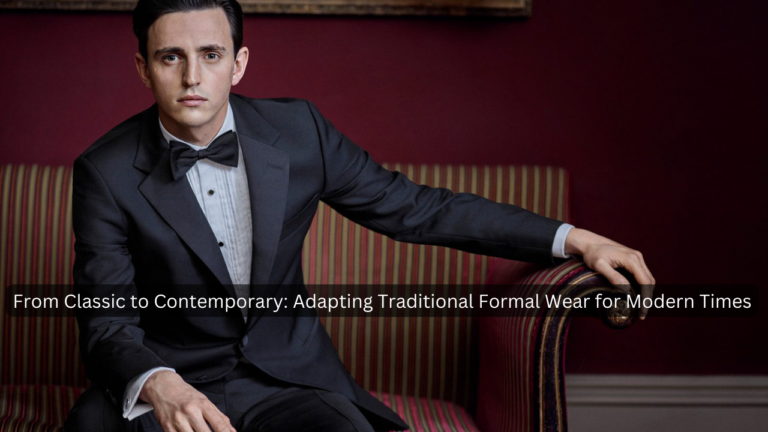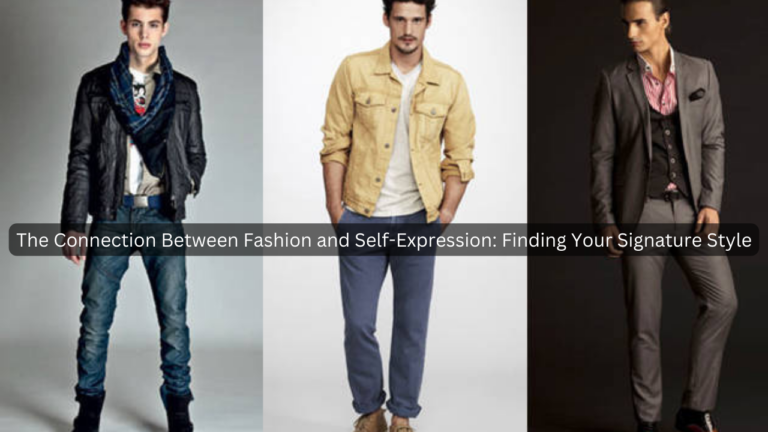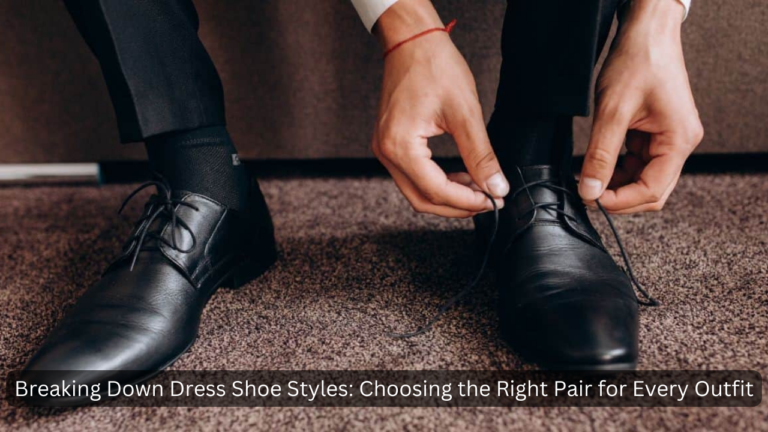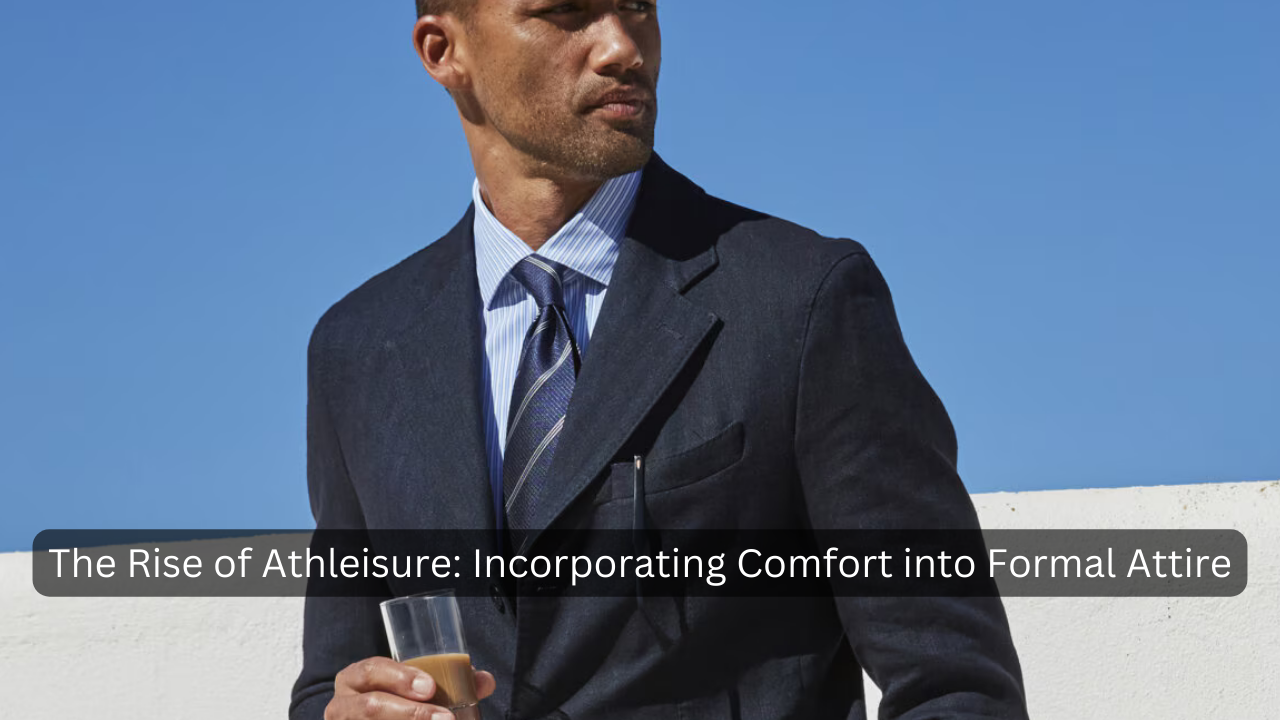
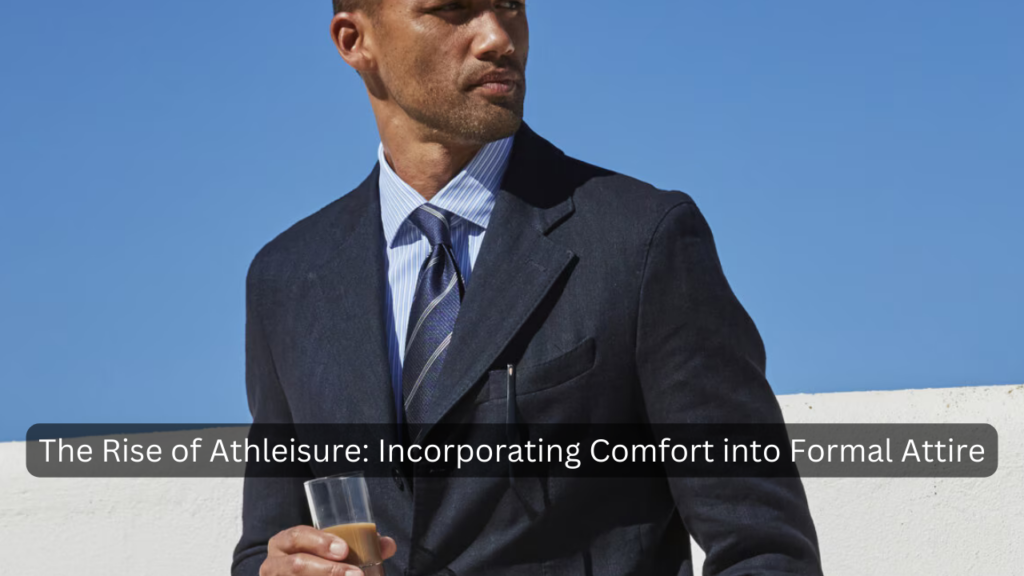
Table of Contents
Introduction
In recent years, a notable shift has occurred in the world of fashion, blurring the once distinct lines between comfort and formality. This evolution is encapsulated in the rise of athleisure, a trend that has revolutionized how we perceive and wear clothing. Athleisure represents a fusion of athletic and leisurewear elements into everyday attire, offering a stylish compromise between comfort and functionality.
Definition of Athleisure and Its Evolution in Fashion
Athleisure can be defined as a style of clothing that combines elements of athletic wear with casual, everyday fashion . What sets athleisure apart is its emphasis on comfort, flexibility, and performance, traditionally associated with sports and fitness activities, now seamlessly integrated into contemporary wardrobes. This trend not only prioritizes practicality but also reflects a broader cultural shift towards a more relaxed approach to dressing.
Brief History of Athleisure’s Emergence in the Fashion Industry
The emergence of athleisure can be traced back to the late 20th century when fitness and wellness movements gained prominence in mainstream culture. Brands initially catering to athletes and fitness enthusiasts began exploring ways to transition their functional apparel into more versatile, everyday wear. This transition gained momentum in the early 2000s as celebrities and influencers embraced athleisure, propelling it from niche market status to a global fashion phenomenon.
The Comfort Revolution: Athleisure’s Influence
Shift in Consumer Preferences towards Comfort and Functionality
Athleisure’s meteoric rise mirrors a significant shift in consumer preferences towards clothing that offers both comfort and functionality. Traditionally, formal attire was synonymous with stiffness and restraint, designed more for appearance than comfort. However, as lifestyles evolve and priorities shift, there has been a growing demand for clothing that supports active lifestyles while maintaining a polished appearance.
Athleisure meets this demand by incorporating performance-driven fabrics and ergonomic designs that allow for ease of movement without sacrificing style. This evolution reflects a broader cultural embrace of wellness and practicality in everyday life, where individuals seek versatile pieces that seamlessly transition from work to leisure.
Impact of Athleisure on Traditional Formal Wear Trends
Athleisure’s influence extends beyond casual settings, permeating even the realm of traditional formal wear. Designers and brands have responded to this trend by integrating athleisure elements into their collections, blurring the boundaries between formal and casual attire. Fabrics once reserved for activewear, such as moisture-wicking blends and stretch materials, are now commonplace in tailored suits and dress shirts.
Moreover, athleisure-inspired silhouettes and details, such as relaxed fits, elastic waistbands, and minimalistic designs, have redefined what is considered appropriate attire for professional environments. This shift not only enhances comfort but also aligns with contemporary notions of style, where versatility and practicality are valued alongside traditional sartorial norms.
In essence, athleisure’s impact on formal wear trends signifies a broader evolution in fashion, where comfort and functionality are no longer sacrificed for style but integrated harmoniously to meet the demands of modern lifestyles.
Blending Worlds: Athleisure Elements in Formal Attire
Exploration of Key Athleisure Elements in Formal Wear
Athleisure has brought a fresh perspective to formal attire by incorporating several key elements that emphasize comfort, functionality, and contemporary style.
Fabrics:
Athleisure-inspired formal wear often features advanced fabrics originally developed for activewear. These include stretch wool blends, technical fabrics with moisture-wicking properties, and breathable textiles. These materials not only enhance comfort by allowing greater freedom of movement but also maintain a sleek, wrinkle-resistant appearance suitable for professional settings.
Cuts and Silhouettes:
Traditional formal wear silhouettes are evolving to accommodate athleisure influences. Tailored suits and dresses now feature relaxed fits, elasticated waistbands, and ergonomic designs that provide a more comfortable, modern fit. This shift towards more flexible cuts ensures that wearers can move with ease throughout the day without compromising on style or elegance.
Design Details:
Athleisure-inspired design details often emphasize minimalism and functionality. Clean lines, discreet pockets, and subtle stitching contribute to a streamlined aesthetic that blends seamlessly into both casual and formal environments. These details not only enhance practicality but also reflect a contemporary approach to formal dressing that values versatility and adaptability.
Examples of How Athleisure Has Influenced Men’s and Women’s Formal Fashion
Men’s Formal Fashion:
In men‘s formal fashion, athleisure influences are evident in the adoption of performance fabrics and sporty details. Tailored suits now incorporate stretch materials for enhanced Incorporating Comfort into Formal Attire, while dress shirts feature moisture-wicking properties to keep wearers cool and dry. Athleisure-inspired accessories like sleek sneakers or hybrid dress shoes blend traditional craftsmanship with modern comfort, offering a stylish alternative to classic footwear.
Women’s Formal Fashion:
For women, athleisure has revolutionized formal fashion by introducing athleisure-inspired dresses and separates that combine elegance with ease of movement. Dresses may feature stretch fabrics and minimalist designs that transition effortlessly from the office to evening events. Athleisure-inspired outerwear such as tailored blazers with functional pockets and lightweight, breathable materials further blur the lines between workwear and casual attire.
Overall, athleisure’s influence on formal wear demonstrates a shift towards a more practical and adaptable approach to dressing. By integrating athleisure elements into traditional formal attire, designers and wearers alike are embracing a new era of fashion that prioritizes comfort, functionality, and contemporary style.
Fashion Forward: Athleisure on the Runway and Red Carpet
Instances of Athleisure-Inspired Outfits Seen in High-Profile Fashion Events
Athleisure’s influence extends beyond everyday wear to high-profile fashion events, where designers and celebrities alike embrace its blend of comfort and style.
At fashion weeks around the world, from New York to Paris, athleisure-inspired pieces have graced the runways. Designers such as Stella McCartney and Alexander Wang have incorporated sporty elements like track pants paired with tailored blazers or athleisure-inspired dresses featuring performance fabrics and minimalist designs. These runway looks not only showcase the versatility of athleisure but also redefine traditional notions of formal wear by infusing it with a youthful, dynamic aesthetic.
Celebrity Endorsements and Designer Collaborations Integrating Athleisure with Formal Wear
Celebrities have played a pivotal role in popularizing athleisure on the red carpet and beyond. Influencers like Rihanna and Beyoncé have been known to rock athleisure-inspired outfits at prestigious events, effortlessly blending Incorporating Comfort into Formal Attire with glamour. Their endorsements have catapulted athleisure from a trend to a staple in haute couture.
Moreover, designer collaborations have further blurred the lines between sportswear and formal attire. Brands such as Nike collaborating with high-end designers like Off-White and Sacai have produced collections that seamlessly integrate athletic-inspired elements into luxury fashion. These collaborations not only appeal to a diverse audience but also challenge traditional fashion norms, encouraging experimentation and innovation in formal wear.
From Gym to Boardroom: Athleisure in Professional Settings
Practical Tips for Incorporating Athleisure into Office Attire without Compromising Professionalism
Athleisure’s evolution allows professionals to blend comfort with corporate sophistication, creating a seamless transition from casual to formal settings.
Choose Quality Fabrics: Opt for tailored pieces made from high-quality, performance fabrics like stretch wool or technical blends. These fabrics offer comfort and flexibility while maintaining a polished appearance.
Focus on Fit: Select athleisure-inspired garments with a tailored fit that complements your body shape. Avoid overly loose or tight clothing that detracts from a professional look.
Layer Thoughtfully: Layering is key to balancing athleisure with professionalism. Pair a structured blazer or tailored jacket with athleisure-inspired trousers or a skirt. This combination merges comfort with a refined aesthetic.
Accessorize Appropriately: Choose accessories that enhance your outfit’s professionalism. Opt for classic shoes like loafers or heels, and incorporate minimalistic jewelry to elevate your ensemble.
Maintain Grooming Standards: Ensure your grooming and personal hygiene align with professional expectations. A well-groomed appearance complements athleisure-inspired attire in a corporate environment.
How Athleisure Can Enhance Comfort and Productivity in Professional Environments
Athleisure’s emphasis on comfort and functionality can significantly enhance productivity in professional settings:
Flexibility and Ease of Movement: Athleisure garments allow for unrestricted movement, which is crucial during long workdays or when transitioning between tasks.
Temperature Regulation: Technical fabrics used in athleisure wick away moisture and regulate body temperature, keeping you cool and comfortable throughout the day.
Reduced Distraction: Comfortable clothing reduces physical discomfort, allowing you to focus more effectively on tasks and interactions.
Adaptability: Athleisure’s versatility allows you to seamlessly transition from office meetings to casual networking events without the need for outfit changes, enhancing efficiency and convenience.
By integrating athleisure into professional attire thoughtfully, professionals can maintain a polished appearance while benefiting from enhanced comfort and productivity in their day-to-day activities. This approach not only reflects modern workplace trends but also supports a balanced lifestyle where style meets functionality.
The Future of Formal Comfort: Trends and Innovations
Predictions for Future Trends Merging Athleisure with Formal Wear
As fashion continues to evolve, the integration of athleisure into formal wear is poised to become even more pronounced, reshaping how we define and approach professional attire.
Hybrid Designs: Expect to see more hybrid designs that seamlessly blend athleisure elements with traditional formal wear. This could include suits with performance fabric panels, dress shirts with moisture-wicking properties, and tailored trousers with stretch capabilities.
Versatile Footwear: Footwear innovations will likely continue to merge comfort and style, with designs like dress sneakers or hybrid shoes that combine the aesthetics of formal footwear with the comfort of athletic shoes.
Casual Formality: The line between formal and casual attire will blur further, with professionals opting for attire that offers both sophistication and ease. This trend reflects a broader shift towards workplace environments that prioritize comfort and flexibility.
Inclusive Sizing and Fit: As athleisure emphasizes inclusivity and diversity, expect to see more brands offering a wider range of sizes and customizable fits in formal athleisure attire. This trend caters to diverse body types and personal preferences.
Innovations in Fabric Technology and Sustainable Athleisure Trends
Advanced Performance Fabrics: Innovations in fabric technology will focus on enhancing comfort, durability, and sustainability. Look for developments in biodegradable and recycled materials, as well as fabrics that offer enhanced breathability and UV protection.
Sustainable Practices: Sustainability will continue to be a driving force in athleisure and fashion as a whole. Brands will increasingly prioritize eco-friendly production methods, such as water-saving techniques, reduced chemical use, and ethical sourcing of materials.
Circular Fashion: The concept of circular fashion, which promotes the recycling and repurposing of clothing, will gain traction in athleisure. Expect to see more initiatives focused on closing the loop in garment production and reducing fashion’s environmental footprint.
Innovative Design Approaches: Designers will explore innovative approaches to athleisure design, such as modular clothing systems that allow for customization and longevity of garments. This trend aligns with consumer demand for versatile, long-lasting clothing.
Conclusion
Athleisure has undeniably revolutionized the world of formal attire, bridging the gap between comfort and traditional style with remarkable ingenuity. This trend, rooted in the desire for practicality and versatility, has reshaped how professionals and fashion enthusiasts alike approach their wardrobes.
Throughout its evolution, athleisure has influenced formal wear in profound ways. It has introduced advanced fabrics that prioritize comfort and functionality without compromising on elegance. Athleisure-inspired designs have redefined silhouettes, offering tailored fits that allow for freedom of movement and adaptability to diverse lifestyles. Moreover, the integration of sporty details and minimalist aesthetics has blurred the lines between casual and formal attire, reflecting a contemporary ethos that values both comfort and sophistication.
Looking forward, the enduring influence of comfort-driven fashion trends, exemplified by athleisure, promises to shape the future of formal attire. As consumer preferences continue to evolve towards clothing that supports active lifestyles and promotes well-being, the demand for innovative fabrics and sustainable practices will drive further advancements in fashion technology. This evolution not only responds to changing societal norms but also empowers individuals to express their personal style while prioritizing comfort and functionality.
In essence, athleisure’s impact on formal attire signifies more than just a trend; it signifies a cultural shift towards a more inclusive and adaptable approach to fashion. By embracing comfort-driven innovations, the fashion industry continues to pave the way for a future where style meets substance, ensuring that individuals can look and feel their best in every aspect of their lives.
